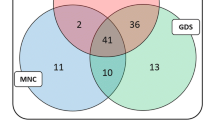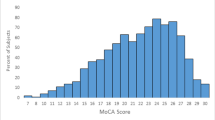Abstract
In the absence of dementia or delirium, cognitive impairment in non-elderly adults is most often associated with intellectual or developmental disability. There is limited information about the prevalence of intellectual disability or its impact on mental disorders and health services use derived from epidemiological studies. Existing assessment measures of intelligence are not easily administered in large, population samples. This study investigates cognitive impairment in the non-elderly utilizing data from the NIMH Epidemiologic Catchment Area Program (ECA). The study also examines the validity and psychometric properties of a newly-developed, brief, and easily administered instrument to assess cognitive impairment in non-elderly adults in community and clinical populations. Utilizing items of the ECA Standardized Psychiatric Examination encompassing three domains—proverb interpretation, fund of knowledge, and interpretation of similarities and differences—a scale (PROFOKS) was developed and validated against various measures and indicators of cognitive impairment in both the community and clinical samples.

Similar content being viewed by others
References
American Association on Mental Retardation (1992). Mental retardation: Definition, classification, and systems of supports (9th edn.), Washington, DC.
Anthony, J. C., Folstein, M., Romanoski, A., Von Korff, M., Nestadt, G., Chahal, R., et al. (1985). Comparison of the lay Diagnostic Interview Schedule and a standardized psychiatric diagnosis: Experience in eastern Baltimore. Archives of General Psychiatry, 42, 667–675.
Axelrod, B. N., & Naugle, R. I. (1998). Evaluation of two brief and reliable estimates of the WAIS-R. The International Journal of Neuroscience, 94(1–2), 85–91.
Bowers, T. L., & Pantle, M. L. (1998). Shipley Institute for Living Scale and the Kaufman Brief Intelligence Test as screening instruments for intelligence. Assessment, 5(2), 187–195.
Bruce, M. L., & McNamara, R. (1992). Psychiatric status among the homebound elderly: An epidemiologic perspective. Journal of the American Geriatrics Society, 40(6), 561–566.
Cooper-Patrick, L., Crum, R. M., Pratt, L. A., Eaton, W. W., & Ford, D. E. (1999). The psychiatric profile of patients with chronic diseases who do not receive regular medical care. International Journal of Psychiatry in Medicine, 29(2), 165–180.
Cowley, A., Newton, J., Sturmey, P., Bouras, N., & Holt, G. (2005). Psychiatric inpatient admission of adults with intellectual disabilities: Predictive factors. American Journal on Mental Retardation, 110(3), 216–225.
Eaton, W. W., Regier, D. A., Locke, B. Z., & Taube, C. A. (1981). The epidemiologic catchment area program of the National Institute of Mental Health. Public Health Reports, 96, 319–325.
Edinger, J. D., Shipley, R. H., Watkins, C. E., Jr., & Hammett, E. B. (1985). Validity of the Wonderlic Personnel Test as brief IQ measure in psychiatric patients. Journal of Consulting and Clinical Psychology, 53(6), 937–939.
Fichter, M. M., Bruce, M. L., Schroppel, H., Meller, I., & Merikangas, K. (1995). Cognitive impairment and depression in the oldest old in a German and in US communities. European Archives of Psychiatry and Clinical Neuroscience, 245(6), 319–325.
Folstein, M. F., Folstein, S. E., & McHugh, P. R. (1975). Mini-Mental State: A practical method for grading the cognitive state of patients for the clinician. Journal of Psychiatric Research, 12, 189–198.
Folstein, M. F., Romanoski, A. J., Nestadt, G., Chahal, R., Merchant, A., Shapiro, S., et al. (1985). Brief report of the clinical reappraisal of the Diagnostic Interview Schedule carried out at the Johns Hopkins site of the Epidemiological Catchment Area Program of the NIMH. Psychological Medicine, 15, 809–814.
Fryers, T. (1987). Epidemiological issues in mental retardation. Journal of Mental Deficiency Research, 31(Pt 4), 365–384.
Gallo, J. J., Rabins, P. V., & Anthony, J. C. (1999). Sadness in older persons: 13-year follow-up of a community sample in Baltimore, Maryland. Psychological Medicine, 29(2), 341–350.
Gustafsson, C. (1997). The prevalence of people with intellectual disability admitted to general hospital psychiatric units: Level of handicap, psychiatric diagnoses and care utilization. Journal of Intellectual Disability Research, 41(Pt 6), 519–526.
Hafner, J. L., Corotto, L. V., & Curnutt, R. H. (1978). The development of a WAIS short form for clinical populations. Journal of Clinical Psychology, 34(4), 935–937.
Hall, W. (1996). What have population surveys revealed about substance use disorders and their co-morbidity with other mental disorders? Drug and Alcohol Review, 15(2), 157–170.
Hand, J. E. (1994). Report of a national survey of older people with lifelong intellectual handicap in New Zealand. Journal of Intellectual Disability Research, 38(Pt 3), 275–287.
Heikura, U., Linna, S. L., Olsen, P., Hartikainen, A. L., Taanila, A., & Jarvelin, M. R. (2005). Etiological survey on intellectual disability in the Northern Finland birth cohort 1986. American Journal on Mental Retardation, 110(3), 171–180.
Hybels, C. F., Blazer, D. G., & Kaplan, B. H. (2000). Social and personal resources and the prevalence of phobic disorder in a community population. Psychological Medicine, 30(3), 705–716.
Janicki, M. P., Davidson, P. W., Henderson, C. M., McCallion, P., Taets, J. D., Force, L. T., et al. (2002). Health characteristics and health services utilization in older adults with intellectual disability living in community residences. Journal of Intellectual Disability Research, 46(Pt 4), 287–298.
Klimczak, N. C., Bradford, K. A., Burright, R. G., & Donovick, P. J. (2000). K-FAST and WRAT-3: Are they really different? The Clinical Neuropsychologist, 14(1), 135–138.
Kramer, M., German, P. S., Anthony, J. C., Von Korff, M., & Skinner, E. A. (1985). Patterns of mental disorders among the elderly residents of eastern Baltimore. Journal of the American Geriatrics Society, 33(4), 236–245.
Kvaal, S. A., Wygonik, E., Spanos, A., & Landsberger, S. (2001). A revalidation of the Thurstone Test of Mental Alertness as a brief measure of intelligence through comparison with the Wechsler Adult Intelligence Scale-III. Psychological Reports, 88(2), 581–586.
La Malfa, G., Lassi, S., Bertelli, M., Salvini, R., & Placidi, G. F. (2004). Autism and intellectual disability: A study of prevalence on a sample of the Italian population. Journal of Intellectual Disability Research, 48(Pt 3), 262–267.
Lyketsos, C. G., Chen, L. S., Anthony, J. C. (1999). Cognitive decline in adulthood: An 11.5 year follow-up of the Baltimore epidemiologic catchment area study. The American Journal of Psychiatry, 156, 58–65.
Mansell, J., Ashman, B., Macdonald, S., & Beadle-Brown, J. (2002). Residential care in the community for adults with intellectual disability: Needs, characteristics and services. Journal of Intellectual Disability Research, 46(Pt 8), 625–633.
Mason, J., & Murphy, G. (2002). People with an intellectual disability in the criminal justice system: Developing an assessment tool for measuring prevalence. The British Journal of Clinical Psychology, 41(Pt 3), 315–320.
Myers, B. A. (1987). The Mini-Mental State in those with developmental disabilities. The Journal of Nervous and Mental Disease, 175(2), 85–89.
Narrow, W. E., Regier, D. A., Norquist, G., Rae, D. S., Kennedy, C., & Arons, B. (2000). Mental health service used by Americans with severe mental illnesses. Social Psychiatry and Psychiatric Epidemiology, 35(4), 147–155.
Pfeiffer, E. (1975). A short Portable Mental Status Questionnaire for the assessment of organic brain deficit in elderly patients. Journal of the American Geriatrics Society, 23(10), 433–441.
Purser, J. L., Fillenbaum, G. G., Pieper, C. F., & Wallace, R. B. (2005). Mild cognitive impairment and 10-year trajectories of disability in the Iowa established populations for epidemiologic studies of the elderly cohart. Journal of the American Geriatrics Society, 53(11), 1966–1972.
Rabins, P. V., Black, B., German, P., Roca, R., McGuire, M., Brant, L., et al. (1996). The prevalence of psychiatric disorders in elderly residents of public housing. Journals of Gerontology. Series A, Biological sciences and Medical Sciences, 51(6), M319–M324.
Rice, D. P., & Miller, L. S. (1998). Health economics and cost implications of anxiety and other mental disorders in the United States. The British Journal of Psychiatry, 173(Suppl. 34), 4–9.
Robbins, L. N., Helzer, H. E., Croughan, J., Williams, J. B. W., & Spitzer, R. L. (1981). NIMH diagnostic interview schedule, version III. Rockville, MD: National Institute of Mental Health.
Shuttleworth-Edwards, A. B., Kemp, R. D., Rust, A. L., Muirhead, J. G., Hartman, N. P., & Radloff, S. E. (2004). Cross-cultural effects on IQ test performance: A review and preliminary normative indications on WAIS-III test performance. Journal of Clinical and Experimental Neuropsychology, 26(7), 903–920.
Silver, J. M., Kramer, R., Greenwald, S., & Weissman, M. (2001). The Association between head injuries and psychiatric disorders: Findings from the New Haven NIMH Epidemiologic Catchment Area Study. Brain Injury, 15(11), 935–945.
Swanson, J., Estroff, S., Swartz, M., Borum, R., Lachicotte, W., Zimmer, C., et al. (1997). Violence and severe mental disorder in clinical and community populations: The effect of psychotic symptoms, comorbity and lack of treatment. Psychiatry, 60(1), 1–22.
Swofford, C. D., Scheller-Gilkey, G., Miller, A. H., Woolwine, B., & Mance, R. (2000). Double jeopardy: Schizophrenia and substance use. The American Journal of Drug and Alcohol Abuse, 26(3), 343–353.
Van Schrojenstein Lantman-de Valk, H. M., Metsemakers, J. F., Soomers-Turlings, M. J., Haveman, M. J., & Crebolder, H. F. (2000). Health problems in people with intellectual disability in general practice: A comparative study. Family Practice, 17(5), 405–407.
Verney, S. P., Granholm, E., Marshall, S. P., Malcarne, V. L., & Saccuzzo, D. P. (2005). Culture-fair cognitive ability assessment: Information processing and psychophysiological approached. Assessment, 12(3), 303–319.
Welch, D. C., & West, R. L. (1999). The Short Portable Mental Status Questionnaire: Assessing cognitive ability in nursing home residents. Nursing Research, 48(6), 329–332.
Yen, Y. C., Yang, M. J., Shih, C. H., & Lung, F. W. (2004). Cognitive impairment and associated risk factors among aged community members. International Journal of Geriatric Psychiatry, 19(6), 564–569.
Zweig, M. H., & Campbell, G. (1993). Receiver-operating characteristics (ROC) plots: A fundamental evaluation tool in clinical medicine. Clinical Chemistry, 39(4), 561–577.
Author information
Authors and Affiliations
Corresponding author
Appendix
Appendix
Rights and permissions
About this article
Cite this article
Galluccci, G., Hackerman, F., Nestadt, G. et al. Cognitive Impairment in the Non-elderly: Validation of a New Tool to Assess Intellectual Disability in Community and Clinical Populations. J Dev Phys Disabil 19, 519–530 (2007). https://doi.org/10.1007/s10882-007-9068-2
Published:
Issue Date:
DOI: https://doi.org/10.1007/s10882-007-9068-2




